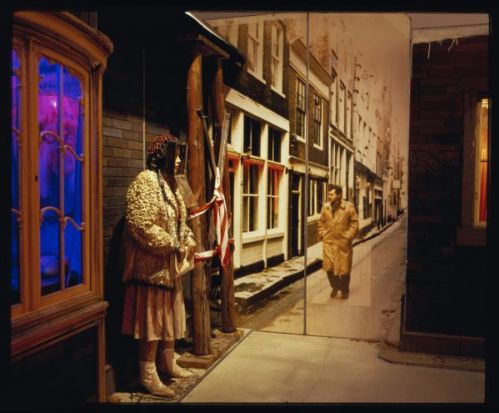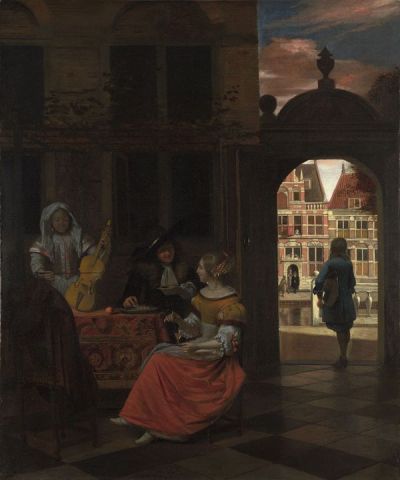Kienholz: The Hoerengracht, National Gallery | reviews, news & interviews
Kienholz: The Hoerengracht, National Gallery
Kienholz: The Hoerengracht, National Gallery
West Coast grunge installation meets 17th century Dutch painting
Entering the Sunley Room – a space normally reserved for rather prim art-historical displays – you find yourself amid clapboard back alleys littered with dead leaves and beer cans. Peering into dingy rooms you see bombed out bikini-clad mannequins fixing their make-up, reading magazines or staring blankly past you. Over their faces are clamped glass boxes, that appear like second windows, while almost every surface in this red-lit netherworld has been smeared with varnish, larded with yellow glaze or – in the case of the windows – spattered with some transparent fluid open to a number of interpretations.
 Even a year ago, this display would have raised eyebrows – I dare say it still will in some quarters. But with the Wallace Collection currently showing Damien Hirst, it seems that making challenging connections between the past and the present is simply what our great classical galleries do these days. Having said that, The Hoerengracht (1983-8, detail pictured right, © Kienholz Estate) is not only infinitely more powerful than Hirst’s feeble Old Master tributes, it is something of a classic in its own right: the last masterpiece of one of the 20th century’s great underrated geniuses.
Even a year ago, this display would have raised eyebrows – I dare say it still will in some quarters. But with the Wallace Collection currently showing Damien Hirst, it seems that making challenging connections between the past and the present is simply what our great classical galleries do these days. Having said that, The Hoerengracht (1983-8, detail pictured right, © Kienholz Estate) is not only infinitely more powerful than Hirst’s feeble Old Master tributes, it is something of a classic in its own right: the last masterpiece of one of the 20th century’s great underrated geniuses.
Born in Washington State, Ed Kienholz (1927-94) trained as a carpenter, and while he became part of the LA Pop Art scene that produced Ed Ruscha (currently enjoying an acclaimed retrospective at the Hayward), he remained something of an outsider to the art world. Groundbreaking installations such as Roxy’s (1961) – a surreal evocation of a Nevada brothel – and The Beanery (1965) – based on a seedy Hollywood bar – have long been acclaimed as iconic works, yet their rawness and intensity remain disconcerting.
While those earlier pieces were constructed from discarded junk in a quasi-surrealist manner, by the time Kienholz came to work on The Hoerengracht in the mid-1980s (a collaboration, like all his work after 1972, with his wife Nancy Reddin) he was casting his figures in plaster from live models.
That probably gives the impression that The Hoerengracht (whores’ canal) is a lot more overtly realistic than it is. While its painstakingly assembled details – ashtrays full of dog-ends, a coat-hanger in the form of splayed legs – will inevitably remind British gallery-goers of Turner Prize nominee Mike Nelson’s creepily exact fictitious environments (and Nelson cites Kienholz as a crucial influence), the resemblance is deceptive.
Indeed, while the piece has been described as a reconstruction or recreation of Amsterdam's red light district, it is nothing of the sort. The only influence Kienholz admitted to was the 1920s collages of the German Dadaist Kurt Schwitters. The Hoerengracht is in effect a vast collage realised in three dimensions, in which the use of materials expresses the artist’s feelings about his subject in a way that nods to both Expressionism and Surrealism, but remains unique to him.
While his first essay into the subject of prostitution – 1961’s Roxy’s – contained a degree of overt disgust inspired by his own youthful experiences, The Hoerengracht, according to its co-creator, Nancy Reddin Kienholz, takes a more equable view. That may be so. But the work’s ambiguity remains troubled and troubling. Beginning with an underage prostitute staring plaintively from a window and ending with a middle-aged woman in bra and pants, blithely absorbed in a magazine, the work can be read as a contemporary harlot’s progress, from vulnerability to jadedness. The revolted tactility of the surfaces in those confining vitrine-like rooms and the dehumanising glass-box masks speak for themselves; though what they are saying it is up to the viewer to deduce.
 While the National Gallery’s display makes valid comparisons with 17th-century Dutch genre painting – showing Pieter de Hooch’s A Musical Party in a Courtyard (pictured left), which alludes directly to the sex trade, in the next room – more challenging comparisons can be made with the polycromed religious sculptures in The Sacred Made Real. The glowing, spookily lit surfaces of Kienholz’s prostitutes react with those of the 17th-century saints and saviours in ways that are extraordinarily resonant and provocative.
While the National Gallery’s display makes valid comparisons with 17th-century Dutch genre painting – showing Pieter de Hooch’s A Musical Party in a Courtyard (pictured left), which alludes directly to the sex trade, in the next room – more challenging comparisons can be made with the polycromed religious sculptures in The Sacred Made Real. The glowing, spookily lit surfaces of Kienholz’s prostitutes react with those of the 17th-century saints and saviours in ways that are extraordinarily resonant and provocative.
Even more importantly, both exhibitions represent art of direct emotional engagement and intensity. It would certainly be wrong to look on Kienholz as a primitive outsider; his approach to formal values such as light and movement is highly sophisticated. Yet unlike more famous contemporaries such as Robert Rauschenberg, with whom his work has many apparent similarities, Kienholz wasn’t concerned primarily with issues of representation - or with art at all - but with the human reality in front of him and his own reaction to it. That raw-edged directness may have impeded his art’s acceptance in his own time, but it makes it feel more relevant than ever today.
more Visual arts
 Yinka Shonibare: Suspended States, Serpentine Gallery review - pure delight
Weighty subject matter treated with the lightest of touch
Yinka Shonibare: Suspended States, Serpentine Gallery review - pure delight
Weighty subject matter treated with the lightest of touch
 Jane Harris: Ellipse, Frac Nouvelle-Aquitaine MÉCA, Bordeaux review - ovals to the fore
Persistence and conviction in the works of the late English painter
Jane Harris: Ellipse, Frac Nouvelle-Aquitaine MÉCA, Bordeaux review - ovals to the fore
Persistence and conviction in the works of the late English painter
 Sargent and Fashion, Tate Britain review - portraiture as a performance
London’s elite posing dressed up to the nines
Sargent and Fashion, Tate Britain review - portraiture as a performance
London’s elite posing dressed up to the nines
 Zineb Sedira: Dreams Have No Titles, Whitechapel Gallery review - a disorientating mix of fact and fiction
An exhibition that begs the question 'What and where is home?'
Zineb Sedira: Dreams Have No Titles, Whitechapel Gallery review - a disorientating mix of fact and fiction
An exhibition that begs the question 'What and where is home?'
 Yoko Ono: Music of the Mind, Tate Modern review - a fitting celebration of the early years
Acknowledgement as a major avant garde artist comes at 90
Yoko Ono: Music of the Mind, Tate Modern review - a fitting celebration of the early years
Acknowledgement as a major avant garde artist comes at 90
 Unravel: The Power and Politics of Textiles in Art, Barbican review - the fabric of dissent
An ambitious exploration of a neglected medium
Unravel: The Power and Politics of Textiles in Art, Barbican review - the fabric of dissent
An ambitious exploration of a neglected medium
 When Forms Come Alive, Hayward Gallery review - how to reduce good art to family fun
Seriously good sculptures presented as little more than playthings or jokes
When Forms Come Alive, Hayward Gallery review - how to reduce good art to family fun
Seriously good sculptures presented as little more than playthings or jokes
 Entangled Pasts 1768-now, Royal Academy review - an institution exploring its racist past
After a long, slow journey from invisibility to agency, black people finally get a look in
Entangled Pasts 1768-now, Royal Academy review - an institution exploring its racist past
After a long, slow journey from invisibility to agency, black people finally get a look in
 Barbara Kruger, Serpentine Gallery review - clever, funny and chilling installations
Exploring the lies, deceptions and hyperbole used to cajole, bully and manipulate us
Barbara Kruger, Serpentine Gallery review - clever, funny and chilling installations
Exploring the lies, deceptions and hyperbole used to cajole, bully and manipulate us
 Richard Dorment: Warhol After Warhol review - beyond criticism
A venerable art critic reflects on the darkest hearts of our aesthetic market
Richard Dorment: Warhol After Warhol review - beyond criticism
A venerable art critic reflects on the darkest hearts of our aesthetic market
 Dineo Seshee Raisibe Bopape: (ka) pheko ye / the dream to come, Kiasma, Helsinki review - psychic archaeology
The South African artist evokes the Finnish landscape in a multisensory installation
Dineo Seshee Raisibe Bopape: (ka) pheko ye / the dream to come, Kiasma, Helsinki review - psychic archaeology
The South African artist evokes the Finnish landscape in a multisensory installation
 Paul Cocksedge: Coalescence, Old Royal Naval College review - all that glitters
An installation explores the origins of a Baroque masterpiece
Paul Cocksedge: Coalescence, Old Royal Naval College review - all that glitters
An installation explores the origins of a Baroque masterpiece

Add comment